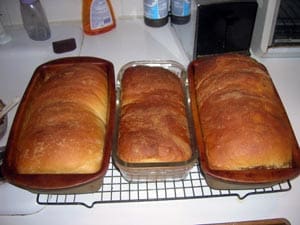 A: According to “Sourdough Cookery”: The Sourdough Cookbook
A: According to “Sourdough Cookery”: The Sourdough CookbookThat’s how The Food Channel editor got her starter–it was given to her by a co-worker more than 10 years ago, and she has been making sourdough bread at least monthly ever since. Sourdough has the advantage in today’s world of being natural, with no preservatives. Sourdough starter is kept alive and is fed and used again for each new batch of dough.
To start your own starter, try this recipe:

2 cups all-purpose flour
1 teaspoon salt
3 tablespoons sugar
1 tablespoon dry yeast
2 cups lukewarm water
With a wooden spoon, stir dry ingredients together in a large mixing bowl and gradually add lukewarm water. Stir until mixture resembles a smooth paste. Cover with a towel or cheesecloth and set in a warm place to sour. Stir mixture several times a day. In 2-3 days sourdough will be ready. Store in a heavy plastic container, with a hole punched in lid to allow gases to escape.
Tips
- Sourdough should be mixed in glass, stoneware or plastic. Do not use metal since it can reduce the purity and change the flavor of the sourdough.
- Store your sourdough in a container with enough head room to allow for expansion.
- Remember that sourdough may double in volume before baking, and again while you bake it, so choose pans of sufficient size for the growth.

